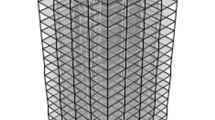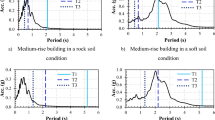Abstract
This paper compares the seismic load of a 5-MW wind turbine supported by a 100-m-high prestressed concrete tower calculated via time history analysis and response spectrum analysis using elastic acceleration spectrum provided by the China Aseismic Code for Buildings. With 5 % damping ratio, the fixed-base multi-degree of freedom model and finite element model considering soil structure interaction are used for response spectrum analysis and time history analysis, respectively. The results indicated that the seismic load calculated by response spectrum analysis is significantly larger than those obtained using the time history analysis method. It implies that the seismic load determined from common building code procedures along with other loads for wind turbine foundation design is too conservative. Within this paper, the effects of damping ratio, horizontal acceleration amplitude, spring stiffness, and damping coefficient of foundation on the seismic load of the prestressed concrete wind turbine tower are discussed. It is shown that the seismic load with mode damping ratio for the prestressed concrete wind turbine tower is not significant when compared with traditional tubular steel tower designs. The maximum moment demand at the base of the tower may be controlled by earthquake loading as the seismic fortification intensity lever is more than seven. The foundation spring stiffness has an immense impact on the base bending moment and the natural frequency. Finally, seismic load should be considered more in detail when designing wind turbines that are supported by concrete towers, particularly for turbines over 100 m height and located in seismically active zones.











Similar content being viewed by others
References
Quilligan A, O’Connor A, Pakrashi A (2012) Fragility analysis of steel and concrete wind turbine towers. Eng Struct 36:270–282
Paredes JA, Barbat AH (2011) Oller S, A compression-tension concrete damage model, applied to a wind turbine reinforced concrete tower. Eng Struct 33:3359–3369
LaNier MW (2005) LWST Project Conceptual Design Study: Evaluation of design and construction approaches for economical hybrid steel/concrete wind turbine towers. Nat Renewable Energy Lab, Golden
Hartea R, Gideon Zijlb Van PAG (2007) Structural stability of concrete wind turbines and solar chimney towers exposed to dynamic wind action. J Wind Eng Ind Aerodyn 95:1079–1096
Lotfy I (2012) Prestressed concrete wind turbine supporting system. MS Thesis, University of Lebraska
Schmitz GM (2013) Design and experimental validation of 328ft (100 m) tall wind turbine towers utilizing high strength and ultra-high performance concrete. MS Thesis, Iowa State University
Ma HW, Meng R (2014) Optimization design of pre-stressed concrete wind turbine tower. Sci China Technol Sci 57:414–422
Otoniel DO (2010) Seismic analysis of horizontal axis wind turbines. Ph.D Thesis, University of Puerto Rico
IEC (2005) IEC 61400-1: Wind turbines-Part I: Design requirements. International electronical Commission, 3rd edition
DNV (2013) Design of offshore wind turbine structures, DNV-OS-J101. Denmark: Det Norske Veritas
GL (2010) Guideline for the certification of wind turbines. Germanischer Lloyd, Hanburg, Germany
Prowell I, Veers P (2009) Assessment of wind turbine seismic risk: Existing literature and simple study of tower moment demand. SANDIA Report
Bazeos N, Hatzigeorgious G, Hondros I, Karamaneas H, Karabalis D (2002) Beskos. D,Static seismic and stability analysis of a prototype wind turbine steel tower. Engineering Structures 24:1015–1025
Witcher D (2005) Seismic analysis of wind turbines in the time domain. Wind Energy 8:81–91
Zhao X, Maisser P (2006) Seismic response analysis of wind turbine towers including soil-structure interaction. Proc of the Inst Mech Eng Part K J Multi-body Dynamics 220(1):53–61
Ishihara T, Sarwar MW (2008) Numerical and Theoretical study of seismic response of wind turbines. http://windeng.t.u-tokyo.ac.jp/ishihara/proceedings/2008-4_paper.pdf
Prowell I, Elgamal A, Uang C (2010) Estimation of seismic load demand for a wind turbine in the time domain. Proceedings of European Wind Energy Conference and Exhibition, warlaw, Poland
Nuta E, Christopoulos C, Packer JA (2011) Methodology for seismic risk assessment for tubular steel wind turbine towers: application to canadian seismic environment. Can J Civ Eng 38:293–304
Kjørlaug RA (2013) Seismic response of wind turbines, Dynamic analysis of a wind turbine in horizontal and vertical direction-subject to earthquake, Wind &SSI. Norwegian University of Science and Technology
Stamatopoulos GN (2013) Response of a wind turbine subjected to near-fault excitation and comparison with the Greek Aseismic Code provisions. Soil Dyn Earthquake Eng 46:77–87
Code for Seismic Design of Buildings (GB 50011-2010), China Architecture& Building Press, Beijing, China, 2010
PEER Strong Ground motion Database. 2015. http://peer.berkeley.edu/products/strong_ground_motion_db.html
ABAQUS: Abaqus Analysis User’s Manual Version 6.11 Documentation. Dassault Systèmes Simulia Corp, 2011
Ma HW (2012) Seismic analysis for wind turbines including SSI, 15WCEE
FD003-2007 (2007) Design regulations on subgrade and foundation for wind turbine generate system. Water Resources and Hydropower Planning and Design General Institute
Load Code for the Design of Building Structures (GB 50009-2012) (2012) China Architecture& Building Press, Beijing, China
Acknowledgment
The authors wish to acknowledge the financial support from the National Basic Research Program of China (973 Program, No. 2014CB046200).
Author information
Authors and Affiliations
Corresponding author
Rights and permissions
About this article
Cite this article
Ma, H., Zhang, D. Seismic Response of a Prestressed Concrete Wind Turbine Tower. Int J Civ Eng 14, 561–571 (2016). https://doi.org/10.1007/s40999-016-0029-y
Received:
Revised:
Accepted:
Published:
Issue Date:
DOI: https://doi.org/10.1007/s40999-016-0029-y




